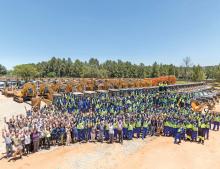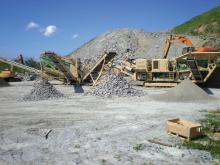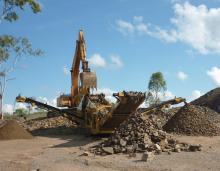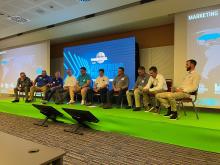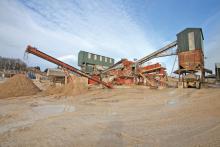
The challenging economy is leading to changes in priorities when buying or renting crushing and screening equipment, finds Lisa Russell
The continued rise of mobile equipment is combining with greater reliance on rentals and growing demand for bigger equipment to bring changes in the crushing and screening market. Rental periods are also becoming longer as users avoid committing themselves to purchasing while uncertain times lie ahead.
“I see more and more demand for mobile equipment,” says
“It’s a lot easier for a big company to get permission to rent for six months than it is to buy,” he says. “We’re seeing rentals for longer periods than before,” says
“What we have been seeing in the past two years is the big aggregates companies saying – really for the first time – that mobile equipment is going to have a much more important place in their portfolio,” he says. It represents a low capital spend if they want to buy outright, and they can move the asset from quarry to quarry.
“We are also seeing tracked mobile equipment moved from country to country. Not only are people looking for flexible financial solutions, but they are also looking for equipment that gives them the greatest flexibility.”
When a new machine is needed, the buyer wants it straightaway. “We see an increasing need for fast lead times in construction,” says Sandvik global product line manager for crushers for construction Mikael Delbrant. Wait too long and the opportunity is gone, especially for mobile products.
Static equipment continues to be very important, “but the demand for mobile equipment increases faster,” he says. It does go both ways though. He recalls a recent discussion with someone who had been a typical mobile customer but is now investing in static plant.
“The more sophisticated customers are looking for higher-tier products and more automation and condition monitoring,” he says. In contrast, other companies chase lower costs and want simple equipment – though not necessarily lower quality products.
The trend to go mobile is happening everywhere, says Sandvik global product line manager for screens and feeders Petri Mehto. But in terms of static equipment, especially in screens, he has seen a clear polarisation of the market in recent months, with a middle group of customers disappearing.
At one extreme, customers, particularly those in bigger companies, are interested in overall value, taking account of lifetime operating costs and performance. They also consider issues such as dust and noise encapsulation. At the opposite extreme, the numbers buying just on price are also increasing.
The difference is partly down to the different types of company, says Mehto. Small contractors chase individual contracts. “When they get a one or two-year contract, they don’t want to put in a huge investment. They are not sure if they can get the next contract or not.”
“Our theme has very much been to drive the product range up in size,” says Brian. These bigger machines have outputs heading towards those of some static machines.
“Higher-capacity machines cost more to buy but they really don’t cost much more to operate,” says Nethery. There has been something of a divergence in the screens market he finds, with people opting either for the smaller end of the mid-sized models, or for larger ones – there is less demand for the middle group. This is understandable, he says.
“If you’ve got a big cat flap you can let little cats in and if you’ve got a big screen you can use it for both big and little jobs.”
HEALTH AND SAFETY
The first thing on the agenda in every meeting is health and safety, says Nethery. The ethos runs through all aspects, from machine design and manufacture right out to the field, he says.
“Doing the thing safely is the most efficient way of doing it anyway.” Environment is also a major focus for Sandvik, says Delbrant, both in daily work with customers and in product development targets.
As well as environmental and safety issues always being top priorities,
“A trend in the industry is to listen more to customers – to get more feedback and be more customer driven,” he says. “How we see this developing is to offer better service to customers on the ground.”
Machines do break, he acknowledges, and it is essential to be able to support customers effectively through a local presence that can get them back up and running as soon as possible. Having offices around the world brings advantages, he says, and helps in ensuring that parts and after-sales services reach customers quickly.
For instance, Atlas Copco has a global presence spanning more than 170 countries. “The market is becoming more competitive,” he says. All crushers will crush, but availability is also of great importance. Atlas Copco has developed a new division, MRS, to handle all its servicing and spare parts.
Powerscreen has been developing strategic relationships with the big aggregates players on a global basis, even though it goes to market via third parties. “Our product development agenda is very much linked to what they are telling us,” says Brian.
As well as machine size, discussions also include the degree of complexity in machines. “I think the challenge for Powerscreen and our peers is how do you take that complexity and make the interface as simple and friendly as possible,” says Brian. “I always use the iPod or iPad as an example. Here you have very sophisticated technology, but to the user it is extremely simple and intuitive. I don’t see the two as mutually exclusive for our equipment either.”
EASE OF USE
Overall ease of use has become more of an issue, says
Increasingly, customers want to tap into the depth of knowledge that manufacturers have about the interaction between equipment at different stages in the process, and the operational choices that can be made. This knowledge can help customers make best use of the equipment, he says. Opportunities can be identified such as changes to wear item or screening media that would improve effectiveness.
Running and wear costs are becoming bigger issues for customers, Nethery finds. There is more value-based selling now, taking account of the total cost of ownership. Customers are not only interested in the product cost but also want to know what it will cost them to run it over a period of five years or so.
“There is a lot of information contained within the company so we can pull together what we can feel are realistic numbers,” he says.
“What we have been emphasising in our development work is driving down the overall operational costs,” says Nakari. One aspect is in optimising the running costs of the machines themselves, including fuel savings. Another is the running of the overall operation. Metso seeks to help customers get the most out of their machines, including related aspects such as moving materials using conveyor-based handling.
How the operation is planned is vital to saving energy. “If you end up producing waste material, then all the energy that goes into its production is being wasted,” says Nakari. It is far better to design the process to produce the required end product with minimal waste. “That is very important when we take the holistic view of energy efficiency.”
Atlas Copco now covers the whole range from drilling and blasting through crushing and screening, following its acquisition of Austria’s Hartl Powercrushers last year. There are opportunities in bringing this knowledge together. “It allows us to go to the customer and start talking about the whole process,” says Montgomery. “Because we now have our own crushers, we can look at the full package. One of the big things is process optimisation: controlling the fragmentation and the blast size so that the blasting suits the crushing and screening.” This involves supporting and guiding the customer in developing the best process for each application. “If you get the blasting right, the crushing and screening become a little easier,” he says.
Nakari sees the main themes in the sector as energy efficiency, safety and the environmental impact of the machines. One driver for development is regulatory and legislative pressure, particularly for engine emissions. In addition, customers are now very active in asking for more than current regulations require. It may help them to secure permits but this is not the only reason for their concern, believes Nakari. “People are genuinely interested in environmental aspects.”
EMISSIONS REQUIREMENTS
Faced with having to make changes in line with the Stage IIIB and Tier 4 engine emissions requirements, the manufacturers have taken the opportunity to introduce other upgrades in parallel, looking afresh at other aspects.
There is increased attention on issues such as noise. The take-up of features such as rubber wear liners is growing. Not only do these protect the machine from wear impact, but they also make it quieter.
Nethery feels that they may have long-term benefits: absorption of vibrations could well increase the life of the machine, although this would be hard to measure.
Much of the drive about noise and dust is coming from the big players, says Brian. “Ten years ago everyone’s focus would have been on how to get more output,” he says. Dialogues now tend to start with discussion of environmental and safety issues.
Being broad-based geographically stands companies in good stead in difficult times, giving the ability to adjust focus as demand fluctuates.
The European market is seen as slow, particularly Ireland, Italy and Spain. Other countries including France, Turkey, Germany and the UK are variously singled out as not being too bad, with useful business also coming from Eastern Europe. India, Africa, Asia Pacific and South America and Australia are mentioned as strong markets by some of the companies.
Atlas Copco also highlights the Middle East. The uncertainty of the global economy is on everyone’s mind. “From our perspective, it is still going well but the period of time you can see into the future is not so long any more,” says Nakari. Customers find it hard to get finance. Projects may be delayed and old equipment may be kept for longer.
“Quite an uncertain few months lie ahead – it’s a hard one to call,” says Nethery. “The good companies are still there – they may not be buying at the same rate but their behaviour is still the same. They want to look at the best products, the best quality, the best value.”
“Like any other international business, Powerscreen is watching the global economy very carefully,” says Brian. The company is gearing up for double-digit growth next year. “But we’re not blind to the fact that some markets potentially could be quite tough,” he says. “It’s been a good year but we’re going into the end of the year with a little more trepidation than we would have liked.”

